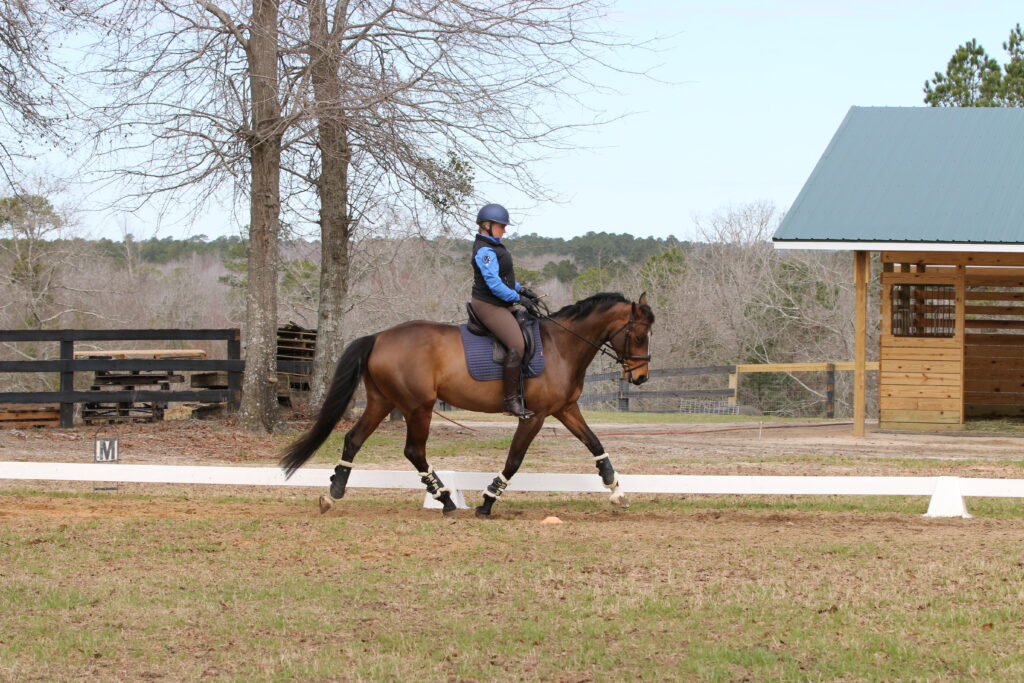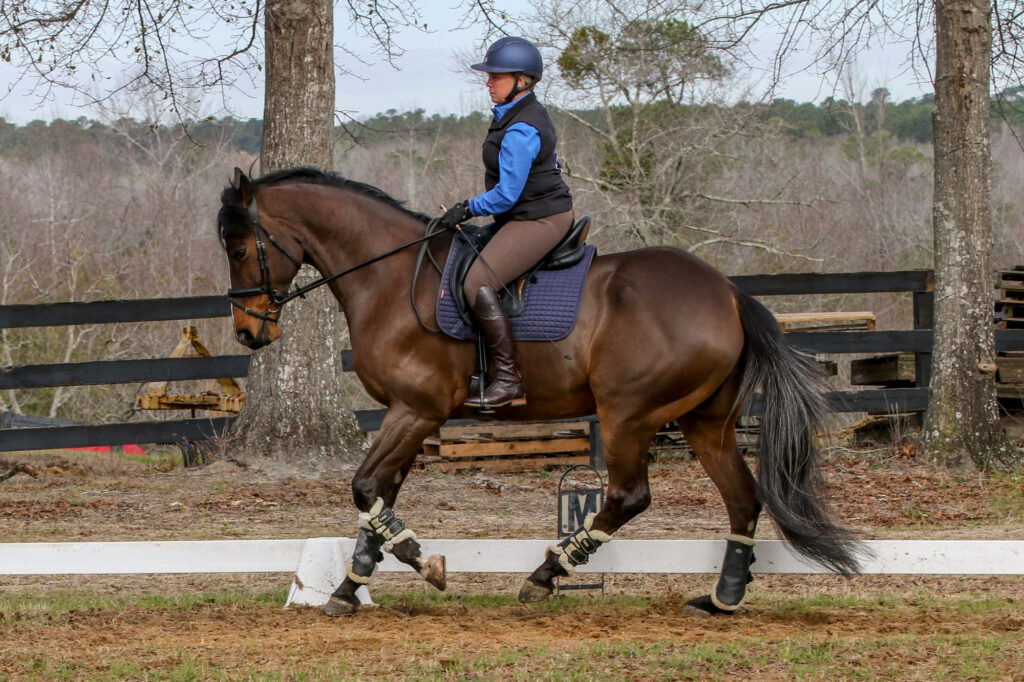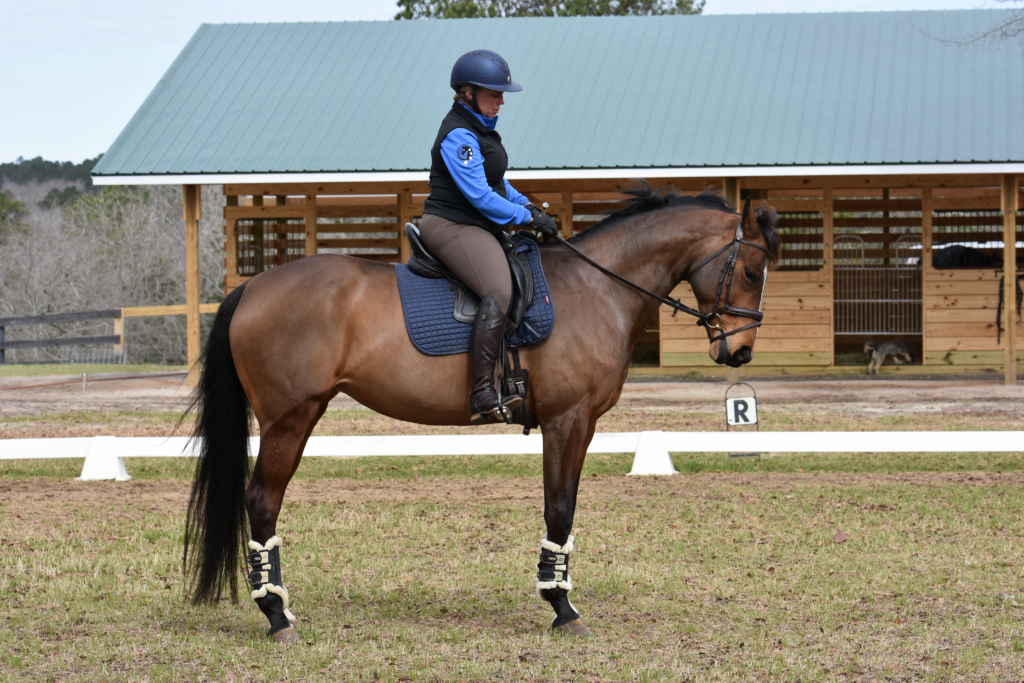This article is sponsored by Cosequin®.
The half-halt—the moment when the driving aids and restraining aids are used very close together to rebalance or slow the horse while maintaining his energy. The USEF Rulebook defines it in part as “A hardly visible, almost simultaneous, coordinated action of the seat, the legs, and the hand of the rider.”
But the half-halt is not just about closing your legs and hands. One goal of the half-halt is to rebalance the horse. For example, an unbalanced horse might feel heavy in your hands, fall on his forehand or feel more strung out.
You also need to use half-halts to control a horse’s energy when you ask him to change his tempo or to let him know that something is about to happen. For example, a change in gait or a change in direction. I like to tell people that the half-halt can be like a car blinker—it indicates what is coming next.

© Sandra Oliynyk
How To Ask For the Half-Halt
I believe in focusing on my legs to ask for the half-halt. If you use your hands to stop the horse’s energy it will cause him to rock down and onto his forehand. I utilize my legs—more specifically, my knees and thighs—to ask for the half-halt. Then I support with my lower leg to maintain the energy. With the energy maintained, the horse rebalances and remains ready for whatever is coming next.
The half-halt is used in all gaits, but to introduce the tool, start at the trot. Here’s how:
- Pick up a working trot on the rail and ride a 20-meter circle. You want your horse moving forward from your lower leg with even, elastic steps and impulsion coming from his hind end into a soft, steady connection with the bit. If you don’t have an arena, use the space you have to ride a large circle.
- As you ask for the working trot, make sure you’re sitting tall, stretching up through your abdomen, and keeping your knees and thighs loose.
- Once you’ve achieved a working trot, ask your horse to collect slightly with a half-halt. Close both knees and thighs against the saddle. Almost immediately, release the pressure from both knees and thighs and add your lower leg to maintain and repackage your horse’s energy. Throughout this, maintain the same soft and steady connection with the bit.
- Hopefully, you’ll feel your horse’s forward energy rock back to his hindquarters and he feels lighter on his front end while collecting slightly. If so, then allow him to continue until you feel him start to lose his balance or you want to change your tempo.
- If you don’t feel any change, repeat the half-halt until you get the correct response.
Once you’re comfortable asking for a half-halt at the trot, try it at the canter.
Halt-Halts with an Experienced Horse
With an experienced horse, like my 18-year-old five-star mount, Covert Rights, half-halts are very subtle. As I canter around the ring, I can maintain a very relaxed knee and thigh so that his energy can flow forward in the gait. In just one stride, I can close my knee and thigh, release them and add my lower leg to rebalance him and allow him to continue moving forward in the canter.
In downward transitions, an experienced horse recognizes that a half-halt is an indicator to rock back on his hind end. For example, before a canter-to-walk transition, I apply the aids above at the canter to let Covert Rights know that a change in gait is about to happen. When I add my leg (Step 4), even though it’s a downward transition, Covert Rights uses that collected energy to perform the transition with an engaged hind end. When he does, the transition is balanced and I can continue forward in the next gait using the energy I created with the half-halt. Without the half-halt, he would most likely fall to his forehand and lean into the bridle during a downward transition.

© Sandra Oliynyk
Half-Halts with a Less-Experienced Horse
For a less-experienced horse or a horse with a more downhill conformation, I will have to use more half-halts to get the job done. With Covert Rights, I can use one half-halt within one stride to get my message across. But with less-experienced horses, I use a lot more half-halts over several strides because they struggle to maintain uphill balance. I use my half-halts to encourage their hind legs to come underneath them without losing the balance and energy. And when horses lose balance, they lose confidence, so it is extra important to utilize half-halts with green horses.
For less-experienced horses, the half-halt within the gaits may be difficult, so I practice them between gaits while the horses are learning. I ride lots of trot–walk, canter–trot and canter–walk transitions, all using my half-halt aids. By riding downward transitions, I’m making it clear to the horse that I’m asking for a change. Again, it may take many small half-halts to ask for the change from one gait to the next. If my horse still isn’t responding—if he loses the shape or balance that I want—then I will ask for a complete halt to really make my point.
Complete the Halt
The completion of the halt is the culmination of the half-halt. While the half-halt collects the energy so that it can be used, the halt is the complete collection of all the energy, which makes it truly stop. To ask for the complete halt, follow the steps of the half-halt above. Though it may seem counterintuitive, you still need to add lower leg through the transition. Doing so creates enough energy to prevent the horse from falling on his forehand. For the complete halt, you will add your hand aids. By closing the hands, you are closing off the energy completely. When you release the thigh and knee pressure and add your leg (Step 6), softly close your hands as well. Once the horse is at a complete halt, release the pressure from your hands but maintain contact with your leg to prevent your horse from backing up.

© Stephanie J. Ruff
Vocal Commands
I use a lot of vocal commands to accompany the aids. They are best taught on the longe line and can then be applied under saddle. For example, a cluck to ask the horse to move forward or a “whoa” to ask him to slow down. When I apply my half-halt aids in a downward transition, I use a “brrr” sound. Doing so draws a correlation between the physical aids and the vocal command.
About Colleen Rutledge

Colleen Rutledge is an international-level event rider. She currently holds the record as being the first person to complete the five Northern Hemisphere five-star events on the same horse, Shiraz (Luke). The events include the Kentucky Three-Day Event (USA), the Badminton Horse Trials (GBR), the Burghley Horse Trials (GBR), Les 5 Etoiles de Pau (FRA) and Luhmühlen Horse Trials (GER). She and Luke completed all of these with no penalties cross country. She made her U.S. Equestrian Team debut in 2015 riding her homebred Covert Rights at the World Equestrian Festival CHIO Aachen (GER). She is based in Mount Airy, Maryland.
For a limited time, watch a free training video of Colleen Rutledge demonstrating the half-halt at equestrianplus.com.
This article is brought to you by Cosequin®. Check out articles in this series with eventers Colleen Rutledge and Phillip Dutton at practicalhorsemanmag.com and with dressage rider Matt McLaughlin at dressagetoday.com.











